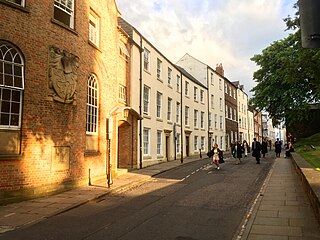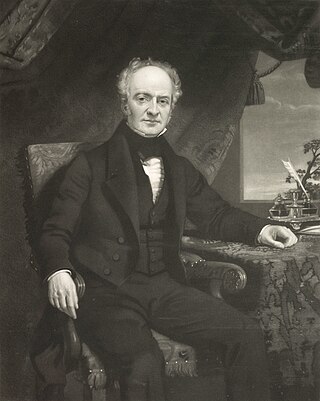
Howard Douglas Horsfall (1856-February 1936) was a stockbroker and benefactor based in Liverpool, England. He is remembered for building churches in Liverpool, and as a founding benefactor of St Chad's College, Durham.

Howard Douglas Horsfall (1856-February 1936) was a stockbroker and benefactor based in Liverpool, England. He is remembered for building churches in Liverpool, and as a founding benefactor of St Chad's College, Durham.
He was the second son of Robert Horsfall, and nephew of Thomas Horsfall, MP for Liverpool. [1]
The Horsfall family had a tradition of building churches: Douglas' grandfather, Charles, was a founder of St George's Church, Everton, and Charles' sons built Christ Church, Everton in his memory. [2] Douglas' father Robert had firm Anglo-Catholic convictions, and funded the building of the Church of St Margaret of Antioch, Liverpool, in 1868. [3]
He studied at Eton College (with William Johnson Cory as his tutor) in 1870-71, before entering his father's stockbroking firm. [1]
Like his father, Horsfall was a firm supporter of the Anglo-Catholic movement, and his benefactions reflected this aim. [1]
In 1883, Horsfall, with his mother, funded the building of the Church of St Agnes and St Pancras, Toxteth Park. It was designed by John Loughborough Pearson and described by Nikolaus Pevsner as "by far the most beautiful Victorian church of Liverpool...an epitome of Late Victorian nobility in church design". [4] in 1975 it received the highest Grade I listing for historical significance.
In 1900 he funded the building of St Faith's Church in Great Crosby. [5]
In 1906, he founded the small chapel of St Pancras, Sefton Park, as a daughter church to St Agnes. This closed in 1937 and was used as a school hall until its demolition in 2003. [6]
In 1913 he funded the building of the Church of St Paul, Liverpool, designed by Giles Gilbert Scott. [5] [1] It is Europe's largest brick-built church, and was used by Scott as a test bed for many ideas later used in Liverpool Cathedral. [6]
Horsfall was also a member of the original committee for the building of Liverpool Cathedral; though he did not make any donation to its building. [7]
In 1904, he became the major benefactor involved in the founding of St Chad's Hall at Durham University, to train Anglo-Catholic priests to serve in the Church of England. [1] He retained this link and continued to give to the hall throughout his life, and was celebrated as "Fundator Noster" (our founder) in the college magazine (although in recent years the college has shared that title with Julia Warde-Aldam, benefactor of the predecessor institution St Chad's Hostel). [8] In 1907, the University awarded Horsfall an honorary degree of Master of Arts in recognition of this support. [1]
The hall survives as St Chad's College, Durham, and Horsfall's portrait hangs over the high table in the dining hall. [8] [9]
In 1887 he married Mabel, daughter of Egerton Parks Smith, and had two sons and two daughters.
His elder son, Captain Robert Elcum Horsfall (1890-1917), studied at Eton College, then worked with Professor John Garstang on archaeological investigations in Egypt and Mesopotamia (including at the discovery of the Meroë Head), before enrolling at King's College, Cambridge. In 1914, he enlisted in the King's Regiment (Liverpool) and was appointed Captain of the 12 Batallion in 1916. He was killed in action in Cambrai on 20 November 1917, aged 27. [10] Oxford University holds a collection of 450 negatives taken by him in Egypt. [11]
Douglas' younger son, Major Ewart Horsfall M.C (1892-1974), was an Olympic and university rower who competed in the 1912 and 1920 Olympic Games before going on to manage the British Olympic rowing team. [1]

St John's College is one of the two recognised colleges of Durham University. The college was established in 1909 as a Church of England theological college and become a full constituent college of the university in 1919. The college consists of John's Hall for students studying on any university course and Cranmer Hall, an Anglican theological college in the open evangelical tradition. All Durham students reading for theology are automatically members of St John's. Started as a men's college, it was the first Church of England theological college to train men and women together and the first Durham college to become coeducational.

St Chad's College is one of the two recognised colleges of Durham University. Founded in 1904 as St Chad’s Hall for the training of Church of England clergy, the college ceased theological training in 1971 and now accommodates students studying the full range of Durham University courses. It is the smallest Durham college by number of undergraduates, but has extensive college library facilities and a strong academic record.

George Frederick Bodley was an English Gothic Revival architect. He was a pupil of Sir George Gilbert Scott, and worked in partnership with Thomas Garner for much of his career. He was one of the founders of Watts & Co.

Hooton Pagnell is a village and civil parish in the Metropolitan Borough of Doncaster in South Yorkshire, England, on the border with West Yorkshire. It lies on the B6422 road, between Brodsworth and South Elmsall and is at an elevation of around 78 metres (256 ft) above sea level. It had a population of 211 at the 2001 Census, reducing slightly to 201 at the 2011 Census. The name of the village derives from Ralph de Paganel, a Norman who was a tenant-in-chief in Yorkshire named in the Domesday Book and an extensive landowner.

The Church of St Agnes and St Pancras is in Ullet Road, Toxteth Park, Liverpool, England. It is recorded in the National Heritage List for England as a designated Grade I listed building, and is an active Anglican church in the diocese of Liverpool, the archdeaconry of Liverpool and the deanery of Toxteth and Wavertree. Pevsner described it as "by far the most beautiful Victorian church of Liverpool...an epitome of Late Victorian nobility in church design".

William Douglas Caröe was a British architect, particularly of churches.

George Goldie was an English ecclesiastical architect who specialised in Roman Catholic churches.

Ewart Douglas Horsfall MC was a British rower who competed in the 1912 Summer Olympics and in the 1920 Summer Olympics.

St Cyprian's Church, Hay Mills is a parish church of the Church of England in Hay Mills, Birmingham, England. It is situated on the southern side of the main Birmingham to Coventry Road A45 at the end of a lane called the Fordrough that leads to the factory of Webster & Horsfall Ltd. It has long been associated with the Horsfall family who built the church and continue to be its owners. Built in the 19th century of red brick in the Gothic Revival style it is dedicated to St Cyprian the third century martyr and Bishop of Carthage who although coming from a wealthy background gave away a portion of his wealth to the poor of Carthage, he was beheaded by the Romans in 258. The church is now Grade II listed.

Rowland Eyles Egerton-Warburton was an English landowner and poet from the Egerton family in Cheshire. He was a devout Anglican in the high church tradition and a local benefactor. He paid for the restoration of his parish church and for the building of two new churches in villages on his estates. He also built cottages and farm buildings in the villages.

The architecture of Liverpool is rooted in the city's development into a major port of the British Empire. It encompasses a variety of architectural styles of the past 300 years, while next to nothing remains of its medieval structures which would have dated back as far as the 13th century. Erected 1716–18, Bluecoat Chambers is supposed to be the oldest surviving building in central Liverpool.

Charles Horsfall was a merchant and slave-owner who served as Mayor of Liverpool 1832–1833.

Merseyside is a metropolitan county in North West England. It was created by the Local Government Act 1972, and consists of the metropolitan boroughs of Knowsley, St Helens, Sefton, Wirral, and the city of Liverpool. Buildings are listed on the recommendation of English Heritage to the Secretary of State for Culture, Media and Sport, who makes the decision whether or not to list the structure. Grade I listed buildings are defined as being of "exceptional interest, sometimes considered to be internationally important"; only 2.5 per cent of listed buildings are included in this grade. This is a complete list of Grade I listed churches in the metropolitan county of Merseyside as recorded in the National Heritage List for England.
John Salusbury Brewis was an English Anglican priest. He was the Principal of St Chad's College, Durham from 1937 to 1947, and the Archdeacon of Doncaster from 1947 to 1954.

Stephen Richard Platt Moulsdale was an Irish Anglican priest and academic administrator.
Robert James "Rob" Wickham is a British Anglican bishop. He has been CEO of the Church Urban Fund since June 2023, having previously served as Bishop of Edmonton 2015–2023. He also served part-time as Acting Bishop of Portsmouth.

St Chad's Hostel, in Hooton Pagnell near Doncaster, England, was a hostel to prepare candidates for theological college. It was opened in 1902 by Frederick Samuel Willoughby, vicar of Hooton Pagnell. In 1904 a sister institution, St Chad's Hall, was opened at the University of Durham.

Frederick Samuel Willoughby (1862-1928) was a Church of England priest, academic administrator and later Old Catholic bishop. While vicar of Hooton Pagnell, he founded and was first principal of St Chad's Hostel, which survives as St Chad's College, Durham.

Sarah Julia Warde-Aldam was a South Yorkshire estate owner, benefactor and hospital commandant.

The Horsfall family was a family notable in Liverpool, UK, especially as traders at the heart of British trade with Africa after 1807, and as religious benefactors whose churches are among the most important religious buildings in the city.